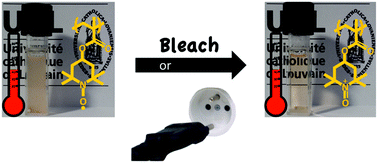Stimuli-responsive polymers exhibit interesting changes in chemical and/or physical properties with exposure to external stimuli which has lead to considerable research into this area of polymer chemistry. Various types of stimuli reported include: light, temperature, pH, mechanical and redox environment. In some cases polymeric materials can be responsive to more than one of these stimuli and as such are dual or multi-responsive. Various redox-responsive polymers have been reported in Polymer Chemistry this month, highlighted below, with applications ranging from sensing, nanolithography and magnetic devices to drug delivery applications.
1. Redox-controlled upper critical solution temperature behaviour of a nitroxide containing polymer in alcohol–water mixtures, Olivier Bertrand, Alexandru Vlad, Richard Hoogenboom, Jean-François Gohy, Polym. Chem., 2016, 7, 1088-1095.
The authors present the synthesis of poly(TEMPO methacrylate) which exhibited UCST behaviour in water/alcohol mixtures. The UCST could be tuned through the water/alcohol ratio as well as which alcohol was used. Oxidation of the nitroxide radical to the oxoammonium cation could be achieved chemically or electrochemically and with increasing oxidation the UCST was decreased. The polymer shows promise for sensing applications.
2. One for all: cobalt-containing polymethacrylates for magnetic ceramics, block copolymerization, unexpected electrochemistry, and stimuli-responsiveness, C. Rüttiger, V. Pfeifer, V. Rittscher, D. Stock, D. Scheid, S. Vowinkel, F. Roth, H. Didzoleit, B. Stühn, J. Elbert, E. Ionescu, M. Gallei, Polym. Chem., 2016, 7, 1129-1137.
A cobalt containing methacrylate was prepared and polymerized by different techniques to form homopolymer and block copolymers. The homopolymers were heated under nitrogen to give magnetic cobalt oxide. The block copolymers were investigated for their reversible reduction and oxidation which lead to the formation of micelles with varying the oxidation state of the cobalt. The polymers have potential in nanolithography and magnetic devices based on soft polymer templates.
3. Oxidation and temperature dual responsive polymers based on phenylboronic acid and N-isopropylacrylamide motifs, Mei Zhang, Cheng-Cheng Song, Ran Ji, Zeng-Ying Qiao, Chao Yang, Fang-Yi Qiu, De-Hai Liang, Fu-Sheng Du, Zi-Chen Li, Polym. Chem., 2016, 7, 1494-1504.
NIPAM and a phenylboronic pinacol ester containing monomer were polymerised to give diblock copolymers, with tunable LCSTs. Triblock copolymers were also prepared with PEG which self-assembled into micelles at 37 °C. The micelles were loaded with doxorubicin and triggered release was achieved through oxidation and elimination of the phenylboronic acid unit. These dual-responsive micelles may have applications in the treatment of inflammation-related diseases or cancers.
Dr. Fiona Hatton is a Web Writer for Polymer Chemistry. She is currently a postdoctoral researcher at KTH Royal Institute of Technology, Sweden, having completed her PhD in the Rannard group at the University of Liverpool, UK. Visit her webpage for more information.











